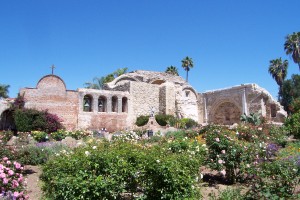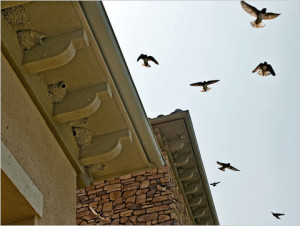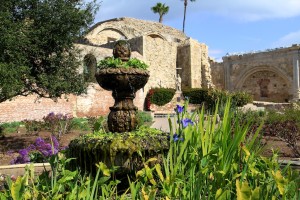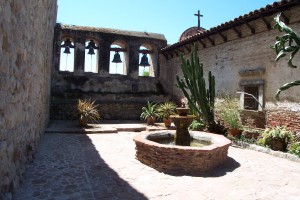 March 19, St. Joseph’s Day, traditionally is the day the swallows return to the Mission San Juan Capistrano in California. Legend has it that when an angry innkeeper had destroyed their nests and the swallows took refuge in the old mission and then returned every spring.
March 19, St. Joseph’s Day, traditionally is the day the swallows return to the Mission San Juan Capistrano in California. Legend has it that when an angry innkeeper had destroyed their nests and the swallows took refuge in the old mission and then returned every spring.
 The American Cliff Swallow is a migratory bird, which for several centuries, has traveled a distance of over 6,000 miles from their winter home in Argentina to this area of Southern California in the spring and summer. “Scout” swallows usually precede and the main flock slowly follows, usually arriving on March 19, and the old Mission bells would be rung in celebration. The San Juan Capistrano Mission area is perfectly located near two rivers where a constant supply of insects is available as a food source and the swallows built their mud nests under the eaves and archways of the Mission, where they are protected within the walls of the old stone church. Then, just as the swallows suddenly arrived, they will leave the area on St. John’s Day, October 23, to travel south and back to Argentina.
The American Cliff Swallow is a migratory bird, which for several centuries, has traveled a distance of over 6,000 miles from their winter home in Argentina to this area of Southern California in the spring and summer. “Scout” swallows usually precede and the main flock slowly follows, usually arriving on March 19, and the old Mission bells would be rung in celebration. The San Juan Capistrano Mission area is perfectly located near two rivers where a constant supply of insects is available as a food source and the swallows built their mud nests under the eaves and archways of the Mission, where they are protected within the walls of the old stone church. Then, just as the swallows suddenly arrived, they will leave the area on St. John’s Day, October 23, to travel south and back to Argentina.
After the 1912 Earthquake, in which the Mission Chapel was severely damaged, an article appeared in a 1915 magazine that reported on the unique phenomenon of the swallows’ annual habit. In hopes of turning the public interest into revenue for the Mission’s restoration project, festivities were planned to draw the tourists to visit the area. As the years passed, this annual event received world notice with radio programs, then television stations reporting on the news of the swallows’ arrival.
In recent years, the swallows have decreased their population from previous seasons. This could be connected to a major increase in the housing development in the area which limited their choices of nesting places and has also affected the decrease in insects for the swallows to eat.
The City of San Juan Capistrano holds a week-long celebration known as the Fiesta de las Golondrinas. Visitors come from around the world to gather and witness the famous return of the swallows to the Mission San Juan Capistrano. For more information regarding the festival, please see the website www.swallowsparade.com
A brief history of the Mission San Juan Capistrano
Seventh in the chain of the 21 California mission settlements of the Catholic Franciscan padres, the Mission San Juan Capistrano was founded by Junipero Serra, on November 1, 1776. The mission was named for the Italian Crusader, Saint John of Capistrano. Built first as a small adobe church 1778, it was later replaced by a much large church to accommodate the growing population in 1782 and has the distinction of being one of the oldest buildings still in use in California.
Hoping to build a truly magnificent church, the padres hired a master stonemason who designed a doomed roof structure made of stone as opposed to the flat wood roofs of the other California Missions. The building was built with stones quarried from the local creek beds and carried to the site by oxen. Limestone was crushed into a powder to create a mortar for the stones when the walls of the mission were built. Constructed in the style of the European churches, the floors were paved with diamond shaped tiles and brick-lined niches displayed statues of the saints. The mission chapel, known as “The Great Stone Church”, was a large 115 foot building constructed in the shape of a cross with a 120 foot tall bell lower (campanile) near the main entrance. At the time, the bell tower could be seen for over 10 miles and the bells could be heard from even farther away.
When construction was completed, it included not only the chapel but also living quarters for the padres and their staff, kitchens and storerooms, workshops and barracks for the soldiers. These buildings formed a quadrangle that was efficient for the daily life at the mission but more importantly for defense against the sometimes hostile natives. Overall, the Mission proved to be a very successful settlement and the padres converted a large number of natives to Christianity. In 1796, over a thousand people lived in or around the Mission compound.
In 1812, a devastating earthquake occurred during Sunday mass and over 40 people lost their lives when they were trapped inside, unable to open the doors, as the walls and the ceiling of the church collapsed. Two boys, who were ringing the bells for the service, and were also killed when the bell tower collapsed. Sadly from this tragic event, a festival celebrating the annual return of the swallows to the Mission San Juan Capistrano was used to raise funds to repair and rebuild the church and surrounding buildings.
Over the years, the mission proved to be a very successful settlement but there were still occasional setbacks in the daily life of the Mission, such as severe storms, followed by flooding which damaged more buildings, disease to the cattle herd and crops ruined by drought. There was even a pirate raid in 1818, when the French pirate Bouchard and his men attacked and engaged in a battle with the Mission soldiers, they looted the Mission warehouses and destroyed several buildings. Finally, even before Mexico gained their independence from Spain in 1821, the population of the Mission had started a slow decline. The mission system was abandoned in 1833 with the Secularization Act, which lead to the further settlement of California, and the missions’ property and land were sold to private interests.
Interesting information and facts about the Mission San Juan Capistrano
- The Mission San Juan Capistrano chapel is sometimes referred to as the Serra Chapel because it is the only known existing structure with documented proof and distinct honor of having Junipero Serra officiating mass at this specific location.
- The bells were an important part of the daily life at the California Missions. They were rung at mealtimes and to signal the people to work and to religious services such as mass, baptisms or funerals. The four Mission San Juan Capistrano bells were all given names. The names from largest to smallest are: San Vicente, San Juan, San Antonio and San Rafael with each bell displaying a Latin inscription. The two largest bells cracked and split open during the 1812 earthquake and were never rung again due to the damage. Within a year a brick bell wall (campanario) had been erected between the ruins of the stone church and the Mission’s first chapel and all four Mission bells were re-hung there.
- Mission San Juan Capistrano was the location of California’s first vineyard. In 1779, the Criollo grape plantings from Spain/Mexico were cultivated and became the only grape used throughout the Mission system. The first winery was also built in San Juan Capistrano in 1783 and the “Mission” grapes produced both red and white wines.
- Father John O’Sullivan is the person credited for recognizing the Mission San Juan Capistrano’s historical value to California. He led efforts to bring national, then world attention to the swallows’ annual return to Capistrano. He used the event as an opportunity to raise funds to rebuild the Mission after the 1912 earthquake. He is buried at the entrance to the cemetery and there is a statue at the front of his crypt.
- There is a song inspired by the swallows which was written by Leon Rene, “When the Swallows Come Back to Capistrano”. It has been recorded over the years by musicians such as Guy Lombardo, Glenn Miller and Pat Boone. There is a room at the Mission San Juan Capistrano to honor the composter, which displays the piano he used to compose the song, copies of the sheet music and other memorabilia donated by the Rene family.


